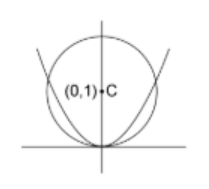
Find the range of \['a'\] for which the parabola \[y=a{{x}^{2}}\] and the unit circle with centre at \[(0,1)\] meet each other at two points other than origin.
Answer
606.9k+ views
Hint: To find the range of \['a'\] for which the parabola and the circle intersect each other at points other than origin, we will first find the equation of the circle with the given centre and then substitute the equation of the parabola in the equation of the circle and solve it to get the desired range.
Complete step-by-step answer:
We have a parabola of the form \[y=a{{x}^{2}}\] and a unit circle with centre at \[(0,1)\].
We want to find the range of \['a'\] for which the two curves will intersect at points other than the origin.
We know that the equation of circle with centre \[(h,k)\] and radius \[r\] is\[{{(x-h)}^{2}}+{{(y-
k)}^{2}}={{r}^{2}}\].
Substituting \[h=0,k=1,r=1\] in the above equation, we get \[{{x}^{2}}+{{(y-1)}^{2}}={{1}^{2}}\]
\[...(1)\] as the equation of our circle.
Now, we have \[y=a{{x}^{2}}\] \[...(2)\] as the equation of our parabola.
To find the point of intersection of the two curves, we will rewrite the equation of parabola
as \[\dfrac{y}{a}={{x}^{2}}\] \[...(3)\]
We will substitute this equation of parabola in equation \[(1)\].
Thus, we get
\[\begin{align}
&\Rightarrow\dfrac{y}{a}+{{(y-1)^{2}}}={{1}^{2}}\\
&\Rightarrow\dfrac{y}{a}+{{y}^{2}}+1-2y=1
\\ &\Rightarrow\dfrac{y}{a}+{{y}^{2}}-2y=0
\end{align}\]

Now factorizing the above equation, we get \[y(\dfrac{1}{a}+y-2)=0\].
So, we have
\[\Rightarrow y=0,y=2-\dfrac{1}{a}\]
Thus, for a point of intersection of two curves other than the origin, we have \[y=2-\dfrac{1}{a}\].
Substituting the above value of \[y\] in the equation \[(3)\], we get \[{{x}^{2}}=\dfrac{y}{a}=\dfrac{2}{a}-\dfrac{1}{{{a}^{2}}}\].
As we are excluding the origin from our point of intersection of the two curves, we have \[{{x}^{2}}>0\]
\[\begin{align}
& \Rightarrow \dfrac{2}{a}-\dfrac{1}{{{a}^{2}}}>0 \\
& \Rightarrow \dfrac{2a-1}{{{a}^{2}}}>0 \\
& \Rightarrow 2a-1>0 \\
& \Rightarrow a>\dfrac{1}{2} \\
\end{align}\]
\[\Rightarrow a\in \left( \dfrac{1}{2},\infty \right)\]
Hence, the required range of value of \['a'\] is \[a\in \left( \dfrac{1}{2},\infty \right)\].
Note: We can also solve this question by substituting the value of \[y\] in terms of \[x\] and then solve for \[x\]. However, that will be time consuming to calculate. Also, one must keep in mind that \[{{x}^{2}}>0\] as we are looking for points of intersection of two curves other than the origin.
Complete step-by-step answer:
We have a parabola of the form \[y=a{{x}^{2}}\] and a unit circle with centre at \[(0,1)\].
We want to find the range of \['a'\] for which the two curves will intersect at points other than the origin.
We know that the equation of circle with centre \[(h,k)\] and radius \[r\] is\[{{(x-h)}^{2}}+{{(y-
k)}^{2}}={{r}^{2}}\].
Substituting \[h=0,k=1,r=1\] in the above equation, we get \[{{x}^{2}}+{{(y-1)}^{2}}={{1}^{2}}\]
\[...(1)\] as the equation of our circle.
Now, we have \[y=a{{x}^{2}}\] \[...(2)\] as the equation of our parabola.
To find the point of intersection of the two curves, we will rewrite the equation of parabola
as \[\dfrac{y}{a}={{x}^{2}}\] \[...(3)\]
We will substitute this equation of parabola in equation \[(1)\].
Thus, we get
\[\begin{align}
&\Rightarrow\dfrac{y}{a}+{{(y-1)^{2}}}={{1}^{2}}\\
&\Rightarrow\dfrac{y}{a}+{{y}^{2}}+1-2y=1
\\ &\Rightarrow\dfrac{y}{a}+{{y}^{2}}-2y=0
\end{align}\]

Now factorizing the above equation, we get \[y(\dfrac{1}{a}+y-2)=0\].
So, we have
\[\Rightarrow y=0,y=2-\dfrac{1}{a}\]
Thus, for a point of intersection of two curves other than the origin, we have \[y=2-\dfrac{1}{a}\].
Substituting the above value of \[y\] in the equation \[(3)\], we get \[{{x}^{2}}=\dfrac{y}{a}=\dfrac{2}{a}-\dfrac{1}{{{a}^{2}}}\].
As we are excluding the origin from our point of intersection of the two curves, we have \[{{x}^{2}}>0\]
\[\begin{align}
& \Rightarrow \dfrac{2}{a}-\dfrac{1}{{{a}^{2}}}>0 \\
& \Rightarrow \dfrac{2a-1}{{{a}^{2}}}>0 \\
& \Rightarrow 2a-1>0 \\
& \Rightarrow a>\dfrac{1}{2} \\
\end{align}\]
\[\Rightarrow a\in \left( \dfrac{1}{2},\infty \right)\]
Hence, the required range of value of \['a'\] is \[a\in \left( \dfrac{1}{2},\infty \right)\].
Note: We can also solve this question by substituting the value of \[y\] in terms of \[x\] and then solve for \[x\]. However, that will be time consuming to calculate. Also, one must keep in mind that \[{{x}^{2}}>0\] as we are looking for points of intersection of two curves other than the origin.
Recently Updated Pages
Why are manures considered better than fertilizers class 11 biology CBSE

Find the coordinates of the midpoint of the line segment class 11 maths CBSE

Distinguish between static friction limiting friction class 11 physics CBSE

The Chairman of the constituent Assembly was A Jawaharlal class 11 social science CBSE

The first National Commission on Labour NCL submitted class 11 social science CBSE

Number of all subshell of n + l 7 is A 4 B 5 C 6 D class 11 chemistry CBSE

Trending doubts
What is meant by exothermic and endothermic reactions class 11 chemistry CBSE

10 examples of friction in our daily life

One Metric ton is equal to kg A 10000 B 1000 C 100 class 11 physics CBSE

1 Quintal is equal to a 110 kg b 10 kg c 100kg d 1000 class 11 physics CBSE

Difference Between Prokaryotic Cells and Eukaryotic Cells

What are Quantum numbers Explain the quantum number class 11 chemistry CBSE




